Folkestone Harbour railway station
Desolation where once the Orient Express arrived.
Report by urban75 editor, July 2006, updated Apr 2008
Built to serve the port of Folkestone in Kent, Folkestone Harbour is one of three stations in the town.
Although now in a dilapidated state and earmarked for demolition, the station once served as a terminus for boat trains from London, connecting with the ferry services to Boulogne and Calais.
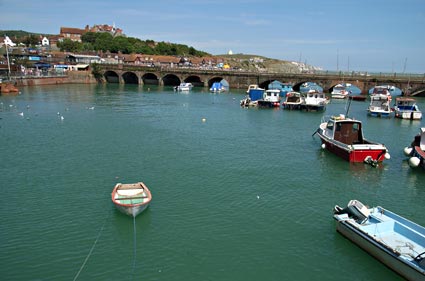
A view looking east across the harbour showing the brick built railway pier leading to the harbour station on the right (just out of view)
History
The line from London, via Reigate and Tonbridge arrived in Folkestone in June 1843 with the connection to the Harbour station being completed some six months later.
The local topography meant that the line to the harbour had to be built on a steep downward gradient, dropping 111 feet for a distance of 1328 yards.
The railway then arrived at right angles to the harbour, with the pier across the sheltered waters splitting the harbour into two, the Inner and Outer Harbours.
Initially, there was no swing bridge provided on the pier, which prevented trains gaining access to steamer berths on the harbour's south side - this was rectified six years later, allowing passenger boat trains to operate for the first time.
Unfortunately, the South Eastern Railway found that it was not legally possible to operate their own steamers, and had to sub-charter vessels from the New Commercial Steam Packet Company.
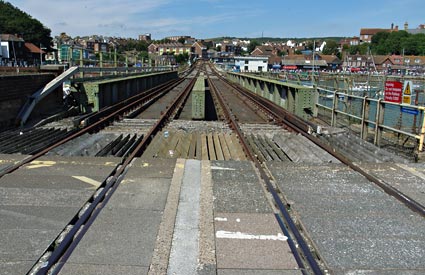
Looking north from the station towards the main line. After crossing the pier, the line turns north-east and climbs a steep gradient to meet the main line at the site of the former Folkestone Junction station.
Cross channel services commence
The cross channel steam packet service opened with much razzamatzz on 1 August 1843, with the 190 ton steamer City of Boulogne steaming into the harbour.
This was promptly followed by the steamship, The Sir William Wallace, heading off to France with 75 passengers onboard, with The Emerald arriving later that day with 142 passengers from France.
The Times reported that the Folkestone – Boulogne crossing took 1 hour 45 minutes in June 1847, making it possible to reach Paris from London in 14 hours.
After the railway reached Boulogne in 1848, the journey time from London to Paris was reduced to 12 and a half hours, being further reduced to a sprightly 11 hours by the time of the Great Exhibition of 1851.
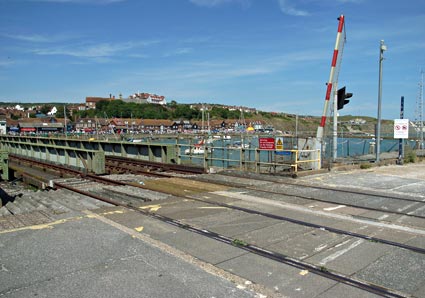
A view of the swing bridge section of the pier, just to the north of the Harbour station.
Unhappy with the restrictions of chartering ships, the railway's directors formed the South Eastern and Continental Steam Packet Company, receiving parliamentary sanction to operate its own steamers in 1853.
The cross channel service continued to prove popular, registering 31,594 passengers in the first half of 1854 (the more lengthy Dover-Calais crossing could only manage 12,132 passengers over the same period).
By 1884, London to Paris (via Folkestone-Boulogne) was reduced to a sprightly 8 hours, being shortened to 7 hours 30 minutes in 1891.
In 1923, the South Eastern & Chatham Railway was absorbed into the Southern Railway, with passenger services suspended during WW2 - these weren't restarted until July 1947, with all UK railway services being nationalised in January 1948.

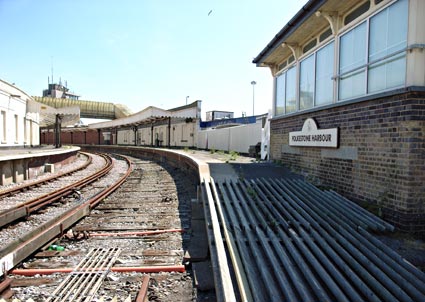
Looking south at the entrance to Folkestone Harbour station. Note the removed track to the right.
Post war services
Folkestone Harbour was never a particularly busy terminus, and in 1953/4 it saw just two trains a day (connecting with the Calais ferries), running seven days a week.
In the summer of 1959, this had risen to (comparatively-speaking) near-rush hour proportions, with four trains a day rumbling into the station every day of the week, connecting with three ferries.
One of these daily trains would be the prestigious 'Golden Arrow' service, once the pride of the line.
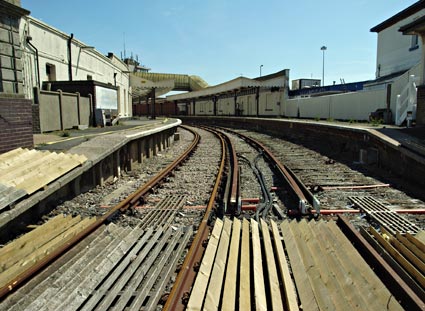
Another view of the entrance to Folkestone Junction station from the level crossing. Curiously, the wooden slats protecting the entrance look almost new, and are still in place for the removed line.
Privatisation and decline
The historic link between the railways and the cross channel service was broken in 1984 thanks to Mrs Thatcher's 'flog off anything that moves' policy, which saw ownership of railway ferries being transferred to the Bermuda-based Sea Containers Ltd.
In recent years, the opening of the Channel Tunnel and the concentration of ferry services elsewhere has seen the end of all Folkestone - Boulogne services, with Folkestone Harbour closing to ordinary rail traffic in 2001.
Despite its semi-derelict state, the station remained open for 'special trains,' with the last passenger train - a steam hauled special - running on 12th April 2008.
A new marina is proposed for the site.
 YouTube video YouTube video

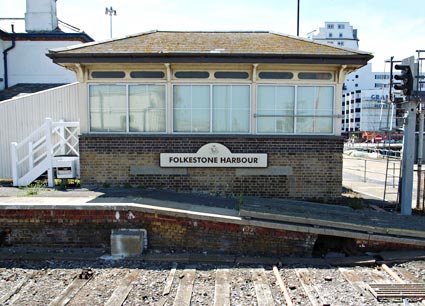
Despite the complete absence of traffic, the signal box remains in excellent condition.
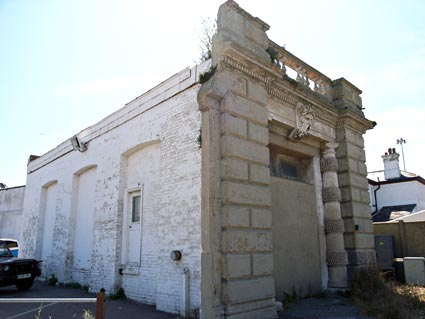
Remains of the station building, on the east platform.
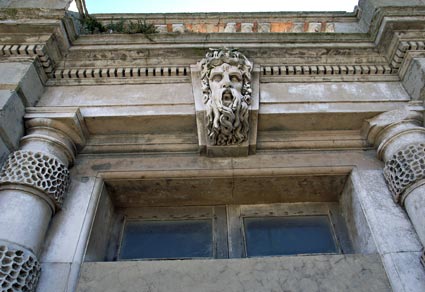
Close up detail.

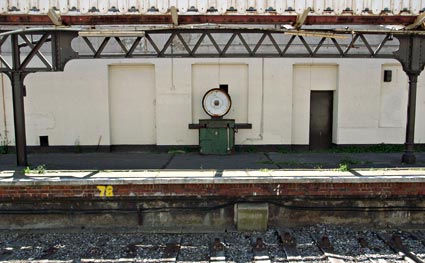
Old weighing machine on the western platform.
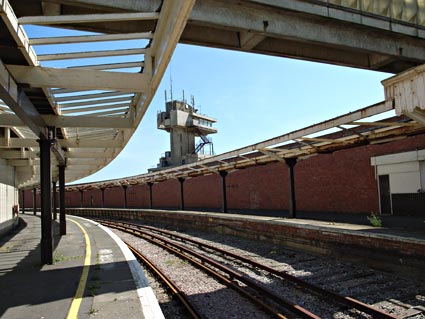
Looking south along the highly curved platforms.
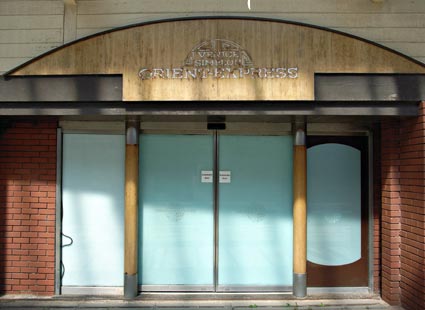
In May 1982, American James B. Sherwood restarted the fabled Orient Express luxury train service, with trains running from London to Victoria to Folkestone harbour.
The service saw beautifully restored Pullman coaches traversing the harbour line, originally to connect with the Boulogne ferry and later to catch a coach to the Channel Tunnel terminal.
From 2002 (I think), the Orient Express no longer terminated at Folkestone Harbour, preferring to use the nearby Folkestone West station instead.
Here you can see the peeling sign of the Orient Express office on the easterly platform.

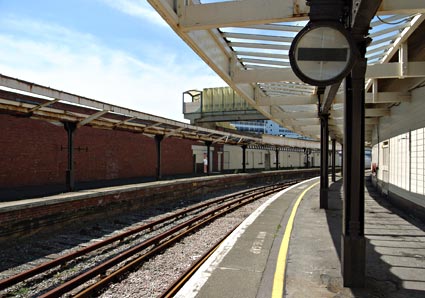
Looking south towards the station entrance. Note the circular 'banner' signal to the right, necessary because of the sharp curvature of the platform.
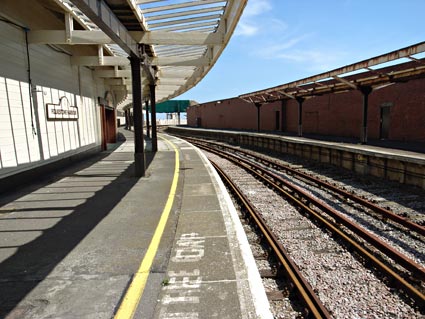
Looking south towards the end of the line.
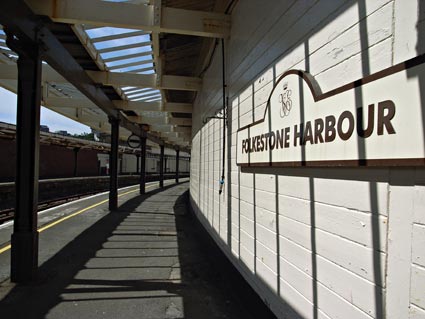
The Orient Express trains may well have stopped running years ago, but the VSOE station signs still look as good as new!
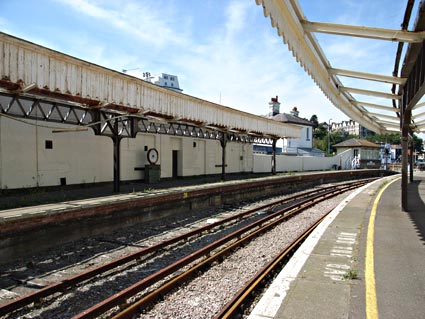
A final look along the platforms towards the signal box. Note the glass-less canopy.
If you look really closely you might just see that the signal by the station box is set to red - which is quite handy seeing as the track has long since been removed!
|

